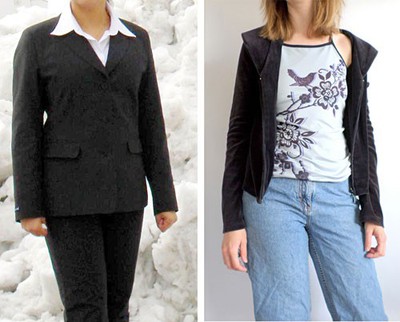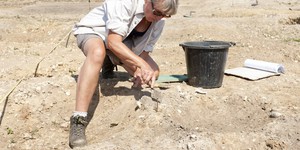Abstract
Do people treat someone differently based on his or her appearance? Specifically, how are their behaviors affected by the clothes a person wears? For instance, if somebody wears a formal suit, do you think others behave differently when interacting with that person compared to if he or she were wearing casual clothes, like blue jeans? In this science project, you will get to try and find out!Summary

Objective
Investigate whether randomly selected people respond differently when asked what time it is by someone dressed in formal clothes compared to somebody wearing casual clothes.Introduction
Your clothing and appearance can say a great deal about you before you even begin to interact with someone. The process of communicating through wordless (and primarily visual) cues like this is referred to as nonverbal communication. The science of "dressing for the part" has become an important factor for witnesses and defendants in the courtroom, job interviews, political candidates, and others who are trying to make a good first impression. Many companies and some schools also have dress codes to make sure employees and students dress appropriately to fit into the desired work or school culture.
In this science project, you will investigate whether a change in clothing—specifically, from formal to informal clothes—can truly make a difference in the way a person responds to you when you ask them what time it is. Examples of people dressed in formal attire and informal attire are shown in Figure 1, below. You can use the resources in the Bibliography, below, to find out more about what type of clothing people typically wear for formal attire (which can also be called professional or business attire) versus informal attire (which can also be called casual attire).

Figure 1. This image shows a picture of a woman dressed in formal attire on the left, and a woman dressed in informal attire on the right. (Left image credits: Wikimedia Commons, Casito, 2007)
Terms and Concepts
- Nonverbal communication
- Dress codes
- Formal attire
- Informal attire
Bibliography
These resources provide some general information on formal attire versus informal attire:
- University of California, Davis. (n.d.). Formal vs. Casual Dress Attire. Graduate School of Management. Retrieved September 10, 2014.
- Wikipedia Contributors. (2014, August 25). Dress code (Western). Retrieved September 10, 2014.
During the 1970's, there were many studies that were conducted on the influence of attire on others' perceptions of an individual making a request. The following graduate thesis offers a great summary of these research studies in the "Review of Literature" section and a detailed listing of sources in the "Bibliography:"
- Cho, W. (2001, May). Influence of Consumer Age and Clothing Type of Salesperson on Consumer Satisfaction with Salesperson's Performance. Virginia Polytechnic Institute and State University. Retrieved September 10, 2014.
Materials and Equipment
- Video camera
- Informal outfit, e.g. blue jeans, cargo pants, t-shirt, tennis shoes, baseball cap
- Formal outfit, e.g. dress slacks, sport jacket, suit, long skirt or dress, dress shoes
- Assistant to run the video camera
- A location where there are many subjects for testing, such as a busy street corner, a shopping mall, or outside of a grocery store
- Lab notebook
Experimental Procedure
Working with Human Test Subjects
There are special considerations when designing an experiment involving human subjects. Fairs affiliated with Regeneron International Science and Engineering Fair (ISEF) often require an Informed Consent Form (permission sheet) for every participant who is questioned. Consult the rules and regulations of the science fair that you are entering, prior to performing experiments or surveys. Please refer to the Science Buddies documents Projects Involving Human Subjects and Scientific Review Committee for additional important requirements. If you are working with minors, you must get advance permission from the children's parents or guardians (and teachers if you are performing the test while they are in school) to make sure that it is all right for the children to participate in the science fair project. Here are suggested guidelines for obtaining permission for working with minors:
- Write a clear description of your science fair project, what you are studying, and what you hope to learn. Include how the child will be tested. Include a paragraph where you get a parent's or guardian's and/or teacher's signature.
- Print out as many copies as you need for each child you will be surveying.
- Pass out the permission sheet to the children or to the teachers of the children to give to the parents. You must have permission for all the children in order to be able to use them as test subjects.
- Select a location at which to intercept a random sampling of people. Some possible locations are a busy street corner, a shopping mall, or outside of a grocery store. Make sure you run the experiment at the same time of day for each day you are testing at the location.
- In order to ensure a consistent review of each of the interactions, you should video tape each of the events.
- Dress up in the informal outfit and go to the location you selected.
- At the location, ask people for the time. Record the interactions and/or write down your observations in your lab notebook after each interaction.
- You may want to make a data table in your lab notebook, in advance, to help you record your observations.
- Repeat step 4 at least 9 times, so that you have asked at least 10 people what time it is.
- The next day, repeat steps 3–5, but this time dress up in the formal outfit.
- Review your videos and observations and analyze the data. Did people respond differently when you were dressed in the informal outfit versus the formal outfit? If so, how was their behavior different? Are you surprised by your results?
- Review the video, note down your results, and analyze the data.
Ask an Expert
Global Connections
The United Nations Sustainable Development Goals (UNSDGs) are a blueprint to achieve a better and more sustainable future for all.
Variations
- You could try this science project again, but this time ask to borrow small amounts of change from different people.
- Instead of dressing in formal or informal attire, you could try dressing as different social stereotypes (e.g., the jock, the nerd, the businesswoman, the mom, etc.) and investigate whether people change their behaviors toward you depending on your outfit.
- Do different people behave differently toward you depending on your outfit? You could try this science project again, but this time try asking different demographic groups (e.g., women, men, kids, senior citizens, etc.). When analyzing your results, see if there are trends in peoples' behaviors based on their demographic groups.
Careers
If you like this project, you might enjoy exploring these related careers:









